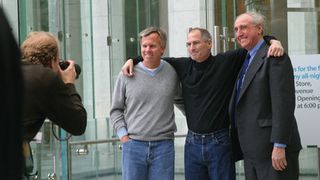Did Apple Stores save Apple?
How Apple became a retail powerhouse
Critics were well aware of Jobs' ability to create buzz around a new product release, but the idea that he could apply the same flair to a store opening had never occurred to them. At heart, he had always been a showman, the difference was his showmanship was rooted in a genuine passion for the retail experience. Each interior was a new canvas for his personal aesthetic, from the authentic Florentine sandstone flooring he demanded, to the specific grey hue of the restroom signs he chose.
In 2002, a historic SoHo, New York former post office was earmarked to house Apple's first 'high-profile' US store. Jobs hired firm Bohlin Cywinski Jackson to help with the design, the beginning of a lasting partnership. He and Peter Bohlin worked closely to create a centrepiece stairway made entirely of glass, the material that would become Apple's signature architectural statement.
Famed for his rustic-modern country houses and Seattle's City Hall, as well as Bill Gates' palatial family compound, Bohlin was in many ways a contemporary of Jobs. A lifelong interest in elemental geometry and "getting to the essence of architecture" mirrored Jobs' penchant for minutiae and zen-like minimalism – converging visions that would reach a culmination in 2006 with Apple's Fifth Avenue NY store, or 'the Cube'.
Bohlin had never designed a whole store before, but that didn't matter to Jobs. He saw Apple Stores as social spaces that were more akin to clubhouses. In response, Bohlin sketched a cubic structure in front of the General Motors tower.
"But how do you motivate people to come down into a space like this?" he wondered. The solution, it turned out, was to turn the cube into a giant skylight – a "ceremony of descent" that would act as both symbol and portal. The Cube boasted 50,000 visitors a week in its first year, and by 2010 had grossed more per square foot than any store in the world. No building has captured the public imagination like it, before or since.
"It was in Apple's DNA to try to make something that no one else had the vision to create," Ron Johnson later recalled. That sequence would be replicated again and again. To date, Apple counts 22 high-profile outlets among its 395 stores in 13 countries. Combined they span 3.1 million feet of leased space (each square foot earning $6,050 per year) and employ over 36,000 staff that serve a million visitors a day. Pretty 'cool', if you ask Apple.
VP vindication

Jobs took medical leave in January 2011, by which time Apple's high-street earnings made up 10% of its total profit. Sensing a job complete and perhaps the end of an era, Ron Johnson left his position as VP of Retail Operations one month after Jobs' death, aiming to repeat his success at the ailing US department store JC Penney.
Get daily insight, inspiration and deals in your inbox
Get the hottest deals available in your inbox plus news, reviews, opinion, analysis and more from the TechRadar team.
Apple's acting CEO, former chief of operations Tim Cook, had kept the ship steady. But with his role made permanent, Cook faced his first big hire, and in January of 2012 tapped Dixons executive John Browett to oversee the company's retail arm. "Our retail stores are all about customer service, and John shares that commitment like no one else we've met," Cook said in a statement. "We are thrilled to have him join our team and bring his incredible retail experience to Apple."
But the recruitment was perceived by many as odd given Browett's management style: Apple stores were clean, spacious, minimalist, whereas Dixons' shops were brightly coloured with shelves that were chock-full of products – and seen by some as perennially understaffed.
Jon Margolis of FT's How to Spend It magazine, summed up the industry rumblings with the tweet, "#Apple has hired bloke from Dixons. Tim Cook very excited about this as he's Mr Customer Service. Has he been to Dixons?" The summation proved prophetic. Browett wasted no time in his aim to lower costs and increase profit margin, and widespread layoffs were reported just weeks before the launch of the iPhone 5.
By August the same year, though, the company had backtracked. "Making these changes was a mistake and the changes are being reversed," said an Apple spokesperson. The statement was likened by blogger John Gruber to Alec Baldwin's dressing-down tirade in Gengarry Glen Ross.
The Loop's Jim Dalrymple called the operational changes "one of the worst decisions Apple had ever made." Seven months later, Apple announced Browett had left the company.
The Peter Principle

Apple hasn't had a head of retail since, yet the high street juggernaut rolls on. In the first quarter of 2013 alone, stores netted $6.44 billion worth sales, up 17% on the previous year.
But is Apple being carried by a legacy in spite of itself? JC Penney's last reported quarter under CEO Ron Johnson has been described as the worst reported by any retailer, ever. Are we witnessing the Peter Principle – that employees tend to rise to their level of incompetence? Was the Johnson-Jobs-Bohlin trio more than the sum of its parts, a unique time in history, never be repeated again?
At New York's Fifth Avenue, customers still descend the glass stairs to enter a stainless steel and stone environment where Apple's lean line of products take centre stage. Custom-designed wooden fixtures, a stainless steel ceiling and an Italian stone floor make an elegant, yet restrained backdrop. The doors remain open 24/7, in the store that never sleeps.
Most Popular

